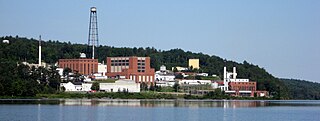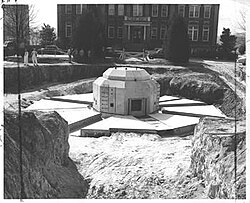
The Atomic Energy Research Establishment (AERE) was the main centre for atomic energy research and development in the United Kingdom from 1946 to the 1990s. It was created, owned and funded by the British Government.
NRX was a heavy-water-moderated, light-water-cooled, nuclear research reactor at the Canadian Chalk River Laboratories, which came into operation in 1947 at a design power rating of 10 MW (thermal), increasing to 42 MW by 1954. At the time of its construction, it was Canada's most expensive science facility and the world's most powerful nuclear research reactor. NRX was remarkable both in terms of its heat output and the number of free neutrons it generated. When a nuclear reactor is operating its nuclear chain reaction generates many free neutrons, and in the late 1940s NRX was the most intense neutron source in the world.

Chalk River Laboratories is a Canadian nuclear research facility in Deep River, about 180 km (110 mi) north-west of Ottawa.
Atomic Energy of Canada Limited (AECL) is a Canadian federal Crown corporation and Canada's largest nuclear science and technology laboratory. AECL developed the CANDU reactor technology starting in the 1950s, and in October 2011 licensed this technology to Candu Energy.

The Bhabha Atomic Research Centre (BARC) is India's premier nuclear research facility, headquartered in Trombay, Mumbai, Maharashtra. Founded by Homi Jehangir Bhabha Atomic Energy Establishment, Trombay (AEET) in January 1954 as a multidisciplinary research program essential for India's nuclear program. It operates under the Department of Atomic Energy (DAE), which is directly overseen by the Prime Minister of India. In 1966 after the death of Mr. Bhabha, AEET was renamed as Bhabha Atomic Research Centre (BARC).

The Aircraft Reactor Experiment (ARE) was an experimental nuclear reactor designed to test the feasibility of fluid-fuel, high-temperature, high-power-density reactors for the propulsion of supersonic aircraft. It operated between November 8-12, 1954 at the Oak Ridge National Laboratory (ORNL) with a maximum sustained power of 2.5 megawatts (MW), and generated a total of 96 MW-hours of energy.
The National Research Universal (NRU) reactor was a 135 MW nuclear research reactor built in the Chalk River Laboratories, Ontario, one of Canada’s national science facilities. It was a multipurpose science facility that served three main roles. It generated radionuclides used to treat or diagnose over 20 million people in 80 countries every year. It was the neutron source for the NRC Canadian Neutron Beam Centre: a materials research centre that grew from the Nobel Prize-winning work of Bertram Brockhouse. It was the test bed for Atomic Energy of Canada Limited to develop fuels and materials for the CANDU reactor. At the time of its retirement on March 31, 2018, it was the world's oldest operating nuclear reactor.

The Reed Research Reactor (RRR) is a research nuclear reactor located on-campus at Reed College in Portland, Oregon. It is a pool-type TRIGA Mark I reactor, built by General Atomics in 1968 and operated since then under licence from the Nuclear Regulatory Commission. Maximum thermal output is 250 kW. The reactor has over 1,000 visitors each year and serves the Reed College departments of Physics and Chemistry, as well as other departments.
The University of Missouri Research Reactor Center (MURR) is home to a tank-type nuclear research reactor that serves the University of Missouri in Columbia, United States. As of March 2012, the MURR is the highest power university research reactor in the U.S. at 10 megawatt thermal output. The fuel is highly enriched uranium.
The Pennsylvania State University (PSU) Radiation Science & Engineering Center (RSEC) houses the Breazeale Nuclear Reactor (BNR). This reactor is the oldest operating in the nation and has undergone numerous power upgrades, renovations, and other changes. The reactor serves the research purposes of the Penn State Department of Mechanical and Nuclear Engineering as well as researchers from industry and other universities. Its total licensed thermal output is 1.1 MW, however the reactor is procedurally limited to 1.0 MW.

The Oregon State University Radiation Center (OSURC) is a research facility that houses a nuclear reactor at Oregon State University (OSU) in Corvallis, Oregon, United States. The Oregon State TRIGA Reactor (OSTR) serves the research needs of the OSU nuclear engineering department along with other departments.

The University of Florida Training Reactor (UFTR), commissioned in 1959, is a 100 kW modified Argonaut-type reactor at the University of Florida in Gainesville, Florida. The UFTR is a light water and graphite moderated, graphite reflected, light water cooled reactor designed and used primarily for training and nuclear research related activities. The UFTR is licensed by the Nuclear Regulatory Commission and is the only research reactor in Florida.
The Ford Nuclear Reactor was a facility at the University of Michigan in Ann Arbor dedicated to investigating the peaceful uses of nuclear power. It was a part of the Michigan Memorial Phoenix Project, a living memorial created to honor the casualties of World War II. The reactor operated from September 1957 until July 3, 2003. During its operation, the FNR was used to study medicine, cellular biology, chemistry, physics, mineralogy, archeology, anthropology, and nuclear science.

The MIT Nuclear Research Reactor (MITR) serves the research purposes of the Massachusetts Institute of Technology. It is a tank-type 6 megawatt reactor that is moderated and cooled by light water and uses heavy water as a reflector. It is the second largest university-based research reactor in the U.S. and has been in operation since 1958. It is the fourth-oldest operating reactor in the country.

Atomics International was a division of the North American Aviation company which engaged principally in the early development of nuclear technology and nuclear reactors for both commercial and government applications. Atomics International was responsible for a number of accomplishments relating to nuclear energy: design, construction and operation of the first nuclear reactor in California (1952), the first nuclear reactor to produce power for a commercial power grid in the United States (1957) and the first nuclear reactor launched into outer space by the United States (1965).

The Washington State University Reactor (WSUR) is housed in the Dodgen Research Facility, and was completed in 1961. The (then) Washington State College Reactor was the brainchild of Harold W. Dodgen, a former researcher on the Manhattan Project where he earned his PhD from 1943 to 1946. He secured funding for the ambitious 'Reactor Project' from the National Science Foundation, the Atomic Energy Commission, and the College administration totaling $479,000. Dodgen's basis for constructing a reactor was that the College was primely located as a training facility for the Hanford site, as well as Idaho National Laboratory because there was no other research reactor in the West at that time. After completing the extensive application and design process with the help of contractors from General Electric they broke ground in August 1957 and the first criticality was achieved on March 7, 1961 at a power level of 1W. They gradually increased power over the next year to achieve their maximum licensed operating power of 100 kW.
The Soreq Applied Research Accelerator Facility (SARAF) is a multi-user and versatile particle accelerator facility. It is based on a proton/deuteron RF superconducting linear accelerator, with variable energy and a continuous wave (CW) high ion current, and located at the Soreq Nuclear Research Center.
ETRR-1 or ET-RR-1, is the first nuclear reactor in Egypt supplied by the USSR in 1958. The reactor is owned and operated by Egyptian Atomic Energy Authority (AEA) at the Nuclear Research Center in Inshas, 40–60 kilometres (25–37 mi) northeast of Cairo.
ETRR-2 or ET-RR-2, or is the second nuclear reactor in Egypt supplied by the Argentine company Investigacion Aplicada (INVAP) in 1992. The reactor is owned and operated by Egyptian Atomic Energy Authority (EAEA) at the Nuclear Research Center in Inshas, 60 kilometres (37 mi) northeast of Cairo.
Medical Research Reactor (MRR) was a research reactor which was located at Brookhaven National Laboratory, a United States Department of Energy national laboratory located in Upton, New York, on Long Island, approximately 60 miles east of New York City. The second of three reactors constructed at BNL, the MRR operated from 1959 until 2000 and has been partially decommissioned.














